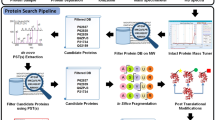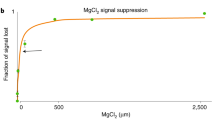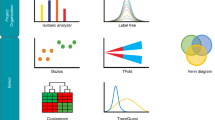Abstract
Mass spectrometry has become a key technology for modern large-scale protein sequencing. Tandem mass spectrometry, the process of peptide ion dissociation followed by mass-to-charge ratio (m/z) analysis, is the critical component for peptide identification. Recent advances in mass spectrometry now permit two discrete, and complementary, types of peptide ion fragmentation: collision-activated dissociation (CAD) and electron transfer dissociation (ETD) on a single instrument. To exploit this complementarity and increase sequencing success rates, we designed and embedded a data-dependent decision tree algorithm (DT) to make unsupervised, real-time decisions of which fragmentation method to use based on precursor charge and m/z. Applying the DT to large-scale proteome analyses of Saccharomyces cerevisiae and human embryonic stem cells, we identified 53,055 peptides in total, which was greater than by using CAD (38,293) or ETD (39,507) alone. In addition, the DT method also identified 7,422 phosphopeptides, compared to either 2,801 (CAD) or 5,874 (ETD) phosphopeptides.
This is a preview of subscription content, access via your institution
Access options
Subscribe to this journal
Receive 12 print issues and online access
$259.00 per year
only $21.58 per issue
Buy this article
- Purchase on Springer Link
- Instant access to full article PDF
Prices may be subject to local taxes which are calculated during checkout





Similar content being viewed by others
References
Aebersold, R. & Mann, M. Mass spectrometry-based proteomics. Nature 422, 198–207 (2003).
Hunt, D.F., Yates, J.R., Shabanowitz, J., Winston, S. & Hauer, C.R. Protein sequencing by tandem mass spectrometry. Proc. Natl. Acad. Sci. USA 83, 6233–6237 (1986).
Coon, J.J., Syka, J.E.P., Shabanowitz, J. & Hunt, D.F. Tandem mass spectrometry for peptide and protein sequence analysis. Biotechniques 38, 519–523 (2005).
Washburn, M.P., Wolters, D. & Yates, J.R. Large-scale analysis of the yeast proteome by multidimensional protein identification technology. Nat. Biotechnol. 19, 242–247 (2001).
Peng, J., Elias, J.E., Thoreen, C.C., Licklider, L.J. & Gygi, S.P. Evaluation of multidimensional chromatography coupled with tandem mass spectrometry (LC/LC-MS/MS) for large-scale protein analysis: the yeast proteome. J. Proteome Res. 2, 43–50 (2003).
de Godoy, L.M.F. et al. Status of complete proteome analysis by mass spectrometry: SILAC labeled yeast as a model system. Genome Biol. 7, R50 (2006).
Good, D.M., Wirtala, M., McAlister, G.C. & Coon, J.J. Performance characteristics of electron transfer dissociation mass spectrometry. Mol. Cell. Proteomics 6, 1942–1951 (2007).
Dongre, A.R., Jones, J.L., Somogyi, A. & Wysocki, V.H. Influence of peptide composition, gas-phase basicity, and chemical modification on fragmentation efficiency: Evidence for the mobile proton model. J. Am. Chem. Soc. 118, 8365–8374 (1996).
Huang, Y. et al. Statistical characterization of the charge state and residue dependence of low-energy CID peptide dissociation patterns. Anal. Chem. 77, 5800–5813 (2005).
Coon, J.J., Syka, J.E.P., Schwartz, J.C., Shabanowitz, J. & Hunt, D.F. Anion dependence in the partitioning between proton and electron transfer in ion/ion reactions. Int. J. Mass Spectrom. 236, 33–42 (2004).
Syka, J.E.P., Coon, J.J., Schroeder, M.J., Shabanowitz, J. & Hunt, D.F. Peptide and protein sequence analysis by electron transfer dissociation mass spectrometry. Proc. Natl. Acad. Sci. USA 101, 9528–9533 (2004).
Coon, J.J. et al. Protein identification using sequential ion/ion reactions and tandem mass spectrometry. Proc. Natl. Acad. Sci. USA 102, 9463–9468 (2005).
Hogan, J.M., Pitteri, S.J., Chrisman, P.A. & McLuckey, S.A. Complementary structural information from a tryptic N-linked glycopeptide via electron transfer ion/ion reactions and collision-induced dissociation. J. Proteome Res. 4, 628–632 (2005).
Pitteri, S.J., Chrisman, P.A., Hogan, J.M. & McLuckey, S.A. Electron transfer ion/ion reactions in a three-dimensional quadrupole ion trap: Reactions of doubly and triply protonated peptides with SO2·–. Anal. Chem. 77, 1831–1839 (2005).
Good, D.M. & Coon, J.J. Advancing proteomics with ion/ion chemistry. Biotechniques 40, 783–789 (2006).
Chi, A. et al. Analysis of phosphorylation sites on proteins from Saccharomyces cerevisiae by electron transfer dissociation (ETD) mass spectrometry. Proc. Natl. Acad. Sci. USA 104, 2193–2198 (2007).
Khidekel, N. et al. Probing the dynamics of O-GlcNAc glycosylation in the brain using quantitative proteomics. Nat. Chem. Biol. 3, 339–348 (2007).
Lecchi, S. et al. Tandem phosphorylation of Ser-911 and Thr-912 at the C terminus of yeast plasma membrane H+-ATPase leads to glucose-dependent activation. J. Biol. Chem. 282, 35471–35481 (2007).
Schwartz, J.C., Senko, M.W. & Syka, J.E.P. A two-dimensional quadrupole ion trap mass spectrometer. J. Am. Soc. Mass Spectrom. 13, 659–669 (2002).
Xia, Y. et al. Implementation of ion/ion reactions in a quadrupole/time-of-flight tandem mass spectrometer. Anal. Chem. 78, 4146–4154 (2006).
McAlister, G.C., Phanstiel, D., Good, D.M., Berggren, W.T. & Coon, J.J. Implementation of electron-transfer dissociation on a hybrid linear ion trap-orbitrap mass spectrometer. Anal. Chem. 79, 3525–3534 (2007).
McAlister, G.C. et al. A proteomics grade electron transfer dissociation-enabled hybrid linear ion trap-orbitrap mass spectrometer. J. Proteome Res. 7, 3127–3136 (2008).
Kaplan, D.A. et al. Electron transfer dissociation in the hexapole collision cell of a hybrid quadrupole-hexapole Fourier transform ion cyclotron resonance mass spectrometer. Rapid. Commun. Mass. Spectrom. 22, 271–278 (2008).
Schroeder, M.J., Shabanowitz, J., Schwartz, J.C., Hunt, D.F. & Coon, J.J. A neutral loss activation method for improved phosphopeptide sequence analysis by quadrupole ion trap mass spectrometry. Anal. Chem. 76, 3590–3598 (2004).
Beausoleil, S.A. et al. Large-scale characterization of HeLa cell nuclear phosphoproteins. Proc. Natl. Acad. Sci. USA 101, 12130–12135 (2004).
Villen, J., Beausoleil, S.A., Gerber, S.A. & Gygi, S.P. Large-scale phosphorylation analysis of mouse liver. Proc. Natl. Acad. Sci. USA 104, 1488–1493 (2007).
Good, D.M., Wirtala, M., McAlister, G.C. & Coon, J.J. Performance characteristics of electron transfer dissociation mass spectrometry. Mol. Cell Proteomics 6, 1942–1951 (2007).
Molina, H., Matthiesen, R., Kandasamy, K. & Pandey, A. Comprehensive comparison of collision induced dissociation and electron transfer dissociation. Anal. Chem. 80, 4825–4835 (2008).
Swaney, D.L. et al. Supplemental activation method for high-efficiency electron-transfer dissociation of doubly protonated peptide precursors. Anal. Chem. 79, 477–485 (2007).
Acknowledgements
We thank J. Griep-Raming, S. Horning, O. Lange, A. Makarov, J. Schwartz, M. Senko, G. Stafford and J. Syka (all at Thermo Scientific) for providing advice and technical assistance during the development of the ETD-Orbitrap instrumentation. We also thank B. Craig, S. Herbst, H. Coon and K. Thompson for growing and collecting the yeast, and J. Antosiewicz-Bourget and J. Thomson for growing the hESCs. We acknowledge J. Marto and S. Ficarro for advice with the Waters chromatography system. We thank G. Barrett-Wilt, D. Good, J. Keith, D. Phanstiel and A. Huhmer for helpful discussions. The University of Wisconsin, the Beckman Foundation, Eli Lilly and the US National Institutes of Health (NIH) (1R01GM080148 to J.J.C.) provided financial support for this work. G.C.M. and D.L.S. acknowledge support from the NIH predoctoral fellowships (Biotechnology Training Program, NIH 5T32GM08349 to G.C.M.; the Genomic Sciences Training Program, NIH 5T32HG002706 to D.L.S.).
Author information
Authors and Affiliations
Contributions
G.C.M., D.L.S. and J.J.C. designed research; G.C.M. and D.L.S. performed research; G.C.M. modified the instrument; and G.C.M., D.L.S. and J.J.C. wrote the paper.
Note: Supplementary information is available on the Nature Methods website.
Corresponding author
Ethics declarations
Competing interests
J.J.C. is a co-inventor on two US patent applications related, in part, to the material presented here.
Supplementary information
Supplementary Text and Figures
Supplementary Figures 1–5, Supplementary Table 1, Supplementary Methods (PDF 287 kb)
Supplementary Data
List of unique peptide identifications (XLS 7892 kb)
Rights and permissions
About this article
Cite this article
Swaney, D., McAlister, G. & Coon, J. Decision tree–driven tandem mass spectrometry for shotgun proteomics. Nat Methods 5, 959–964 (2008). https://doi.org/10.1038/nmeth.1260
Received:
Accepted:
Published:
Issue Date:
DOI: https://doi.org/10.1038/nmeth.1260
This article is cited by
-
Improved online LC-MS/MS identification of O-glycosites by EThcD fragmentation, chemoenzymatic reaction, and SPE enrichment
Glycoconjugate Journal (2021)
-
Toward an efficient workflow for the analysis of the human milk peptidome
Analytical and Bioanalytical Chemistry (2019)
-
Identification of proteins responding to pathogen-infection in the red alga Pyropia yezoensis using iTRAQ quantitative proteomics
BMC Genomics (2018)
-
Precursor and Neutral Loss Scans in an RF Scanning Linear Quadrupole Ion Trap
Journal of the American Society for Mass Spectrometry (2018)
-
Single Analyzer Precursor Ion Scans in a Linear Quadrupole Ion Trap Using Orthogonal Double Resonance Excitation
Journal of the American Society for Mass Spectrometry (2017)



